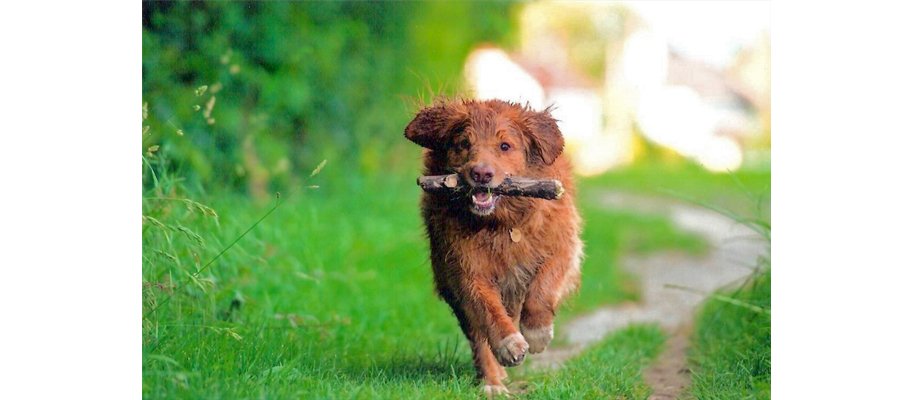Monty* suffers from a dog health problem called osteochondrosis. It is a disease of the bone cartilage that affects his shoulder joints.
It is a condition whereby the the normal process of bone development is disrupted. This disturbance causes irregular and continued growth of the cartilage found at the end of the bone, and this results in abnormally thick areas of cartilage which are less resistant to the everyday stress which is placed on the joint (i.e. when a dog runs or jumps).
Instead of being attached to the bone it covers, the abnormally thick, brittle cartilage, actually separates or cracks. A loose flap of cartilage may form, or entire pieces or fragments may break off, drifting into the inside of the joint.
Inevitably, the body reacts in such a way as to try and remove the invading tissue, and this causes the joint to become inflamed. Over time, this inflammation will lead to subsequent degenerative joint disease.
The most common joint affected osteochondrosis is the shoulder, however, the elbow, knee, ankle, hip, wrists and foot are also susceptible. Osteochondrosis is common in young, fast growing, medium and large breed dogs, and generally occurs when the animal is between 4 and 10 months of age.
Causes
There are many possible causes for this condition in dogs. It could be genetically acquired, and indicates the possibility of a genetic link between parents and their puppies and the formation of the disease. Certain genetic lines and breeds are more likely to develop the disease and condition specific screening is recommended. Osteochondrosis can also come about because of a disruption in the flow of blood to the bone cartilage. In this case, rapid cartilage growth can surpass its own blood supply, leading to a failure in the blood supply to the growing cartilage, or a disruption in the blood supply to the underlying bone.
The condition can occur due to a direct injury to the cartilage which then may lead to cartilage separation from the bone, or cause a decrease in blood supply which could contribute to the formation of cartilage flaps. Nutritional deficiencies or hormone imbalances can also be a cause of osteochondrosis.
Furthermore, the incidence of the disease could be brought about by overfeeding (therefore influencing rapid growth) or over exercise in young, maturing dogs.
Symptoms
As with other orthopaedic conditions, a dog who suffers with osteochondrosis may display the following symptoms:
- Lameness – usually in the affected leg, but may involve one or more legs. Onset of lameness may sudden or gradual, and usually becomes worse after exercise. Lameness may be noticeable on rising, or after periods of inactivity.
- Inability to weight bear on the affected limb
- Dog may show an unwillingness to exercise
- Change in gait – including a shortened forelimb stride due to the reluctance to flex and extend the shoulder joint
- Swelling and heat at joints
- Leg pain, mainly at affected area during any joint manipulation
- Muscle wastage of the affected leg
Treatment
- Exercise modification – cartilage is more susceptible to damage and breaking up during exercise, therefore limited, low-impact exercise is recommended. Scenting games and core strength exercises are a great ‘energy-sappers’.
- Keyhole surgery – for more severe cases where defect or cartilage fragments are removed
- Medication – to relieve pain and inflammation, as well as supplements to promote joint health
- Dietary modification – critical for aiding prevention of the disease in young, maturing dogs
Massage treatment for Osteochondrosis
Massage will assist with easing the tension and pain throughout the body, including both the affected and opposing limbs.
We see Monty for regular massage treatments. He also attends the ‘Fit for Life’ class at Active Paws, which is specifically designed to help those dogs who need more careful exercise.
*Photograph courtesy of Rhian White, www.brightondogphotography.co.uk
Sources
- Colville, T., Bassert, J.M., 2008. Clinical Anatomy and Physiology for Veterinary Technicians. 2nd ed. St. Louis: Mosby Elsevier.
- enpevet, 2009. Dog: Osteochondritis. Available at: http://www.enpevet.de/Lexicon/ShowArticle.aspx?articleid=41053&language=en&noop=.
- Fitzpatrick Referrals, 2008-2014. Elbow Osteochondritis Dissecans (OCD). Available at: http://www.fitzpatrickreferrals.co.uk/our-services/surgery/conditions/fore-limb/elbow-osteochondritis-dissecans-ocd.
- Foster and Smith, 1997-2013a. Osteochondritis Dissecans. Available at: http://www.peteducation.com/article.cfm?c=2+2084&aid=464.
- Houredebaigt, J-P., 2004. Canine Massage – A Complete Reference Manual. 2nd ed. Wenatchee: Dogwise Publishing.
- petMD, 1999-2014a. Osteochondritis Dissecans (OCD) in Dogs. Available at: http://www.petmd.com/dog/conditions/musculoskeletal/c_dg_osteochondrosis.
- Robertson, J., Mead, A., 2013. Physical Therapy and Massage for the Dog. London: Manson Publishing Ltd.
- VCA Animal Hospitals, 2014a. Osteochondritis Dissecans or OCD in Dogs. Available at: http://www.vcahospitals.com/main/pet-health-information/article/animal-health/osteochondritis-dissecans-or-ocd-in-dogs/1045.
